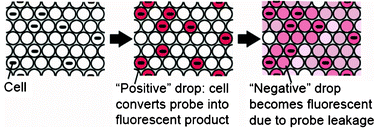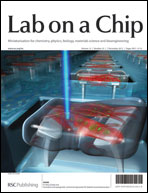Characterization of sensitivity and specificity in leaky droplet-based assays†
Abstract
This paper uses numerical methods to characterize the crosstalk of small fluorescent molecules and molecular probes among aqueous droplets immersed in a continuous phase of hydrocarbons or fluorocarbons in microfluidic systems. Droplet-based biochemical assays rely on the reagents to remain isolated in individual droplets. It has been observed, however, that small and hydrophobic fluorescent molecules can diffuse across the droplet boundary into other drops. The contents among droplets become mixed and homogenized over time. Such cross-contamination can have detrimental effects on the accuracy of droplet-based assays, especially those using fluorescent molecules and the corresponding number of fluorescent droplets for a quantitative readout. This work examines the competing dynamics of the generation of fluorescent molecules in “positive” drops (in response to the presence of molecules or cells of interest), against its leakage into “negative” drops, where such molecules or cells of interest are absent. In ideal droplet assays, the signal-to-noise ratio (SNR)—defined as the fluorescence signal from a positive drop to that from a negative drop—would increase and saturate with time. In a leaky droplet assay, the SNR tends to decay with time. Under certain conditions, however, the SNR from a leaky droplet assay could increase and reach a maximum value before it starts to diminish. This maximum value can be estimated from a dimensionless number relating the rate of leakage relative to the rate of generation of fluorescence signal in the drops. Beyond the time when the SNR peaks, the SNR value, as well as the accuracy of the leaky droplet assay continues to degrade. In the absence of immediate experimental remedies to completely eliminate the crosstalk of molecules among drops, performing detection at the optimal time point becomes critical to minimize errors in leaky droplet assays.


 Please wait while we load your content...
Please wait while we load your content...